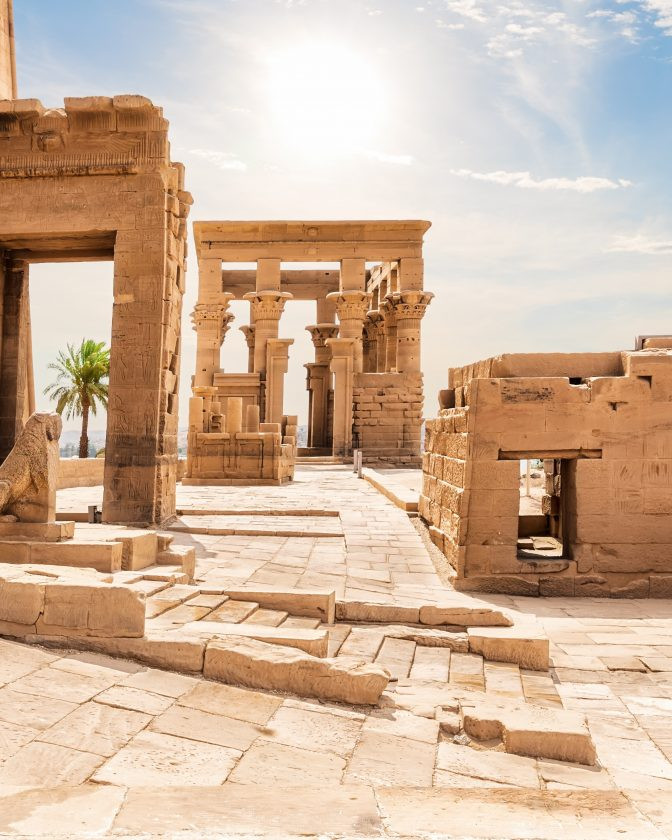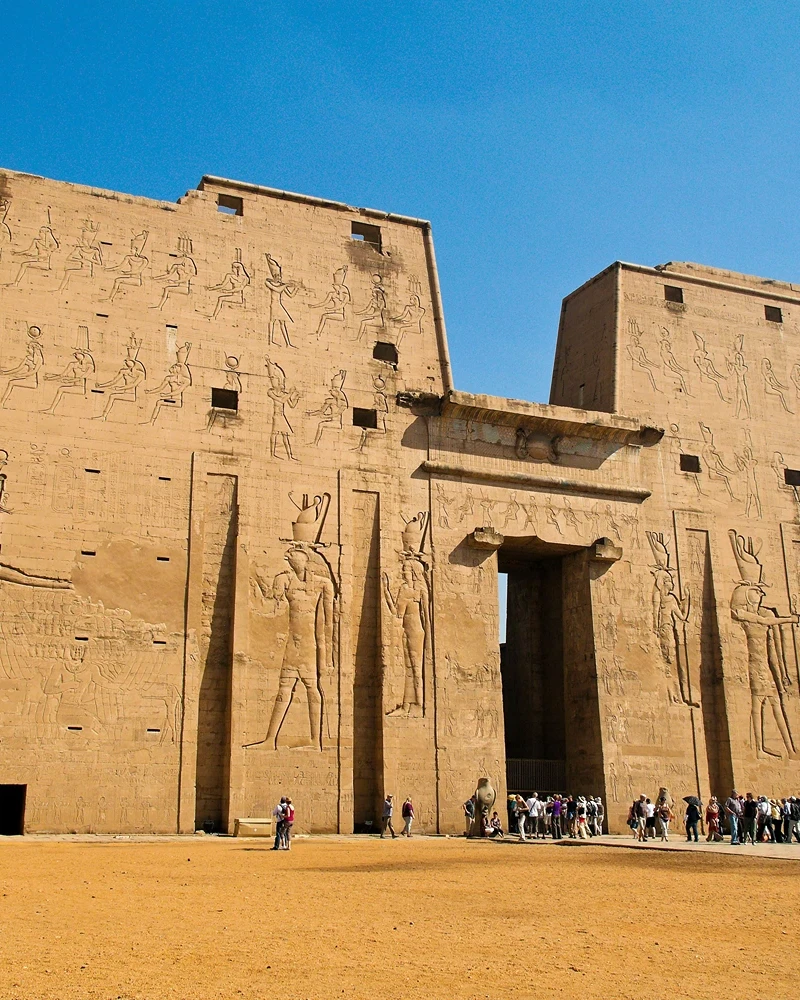Imagine walking through a gateway to a bygone era, where the grandeur of ancient Egyptian civilization stands timeless. Luxor Temple, an architectural marvel on the east bank of the Nile River, offers just that transcendent experience. Built by Amenhotep III in the 18th Dynasty, this temple wasn’t just a monumental feat; it was the heart of the Opet Festival, celebrating divine fertility and royal power. In this article, we delve into Luxor Temple’s historical significance, architectural splendor, and cultural impact, unraveling why it continues to captivate historians and travelers alike.
Historical Background of Luxor Temple
Luxor Temple, located on the east bank of the Nile, was constructed by Amenhotep III during the 18th Dynasty. This monumental structure stands as a testament to the architectural prowess of ancient Egypt and was dedicated to the Theban Triad: Amun, Mut, and Khonsu.
The temple played a central role in the religious life of Thebes, especially during the annual Opet Festival. This festival was a significant event that celebrated the fertility of Amun-Re and the Pharaoh. The processions and rituals associated with the Opet Festival were meant to reinforce the divine nature of the Pharaoh and ensure the prosperity of the land.
- 1392 BC: Construction by Amenhotep III begins.
- 1884: Excavations start under Professor Gaston Maspero.
- 323 BC: Alexander the Great is crowned at Luxor Temple.
- 4th Century AD: Temple is converted into a Christian church.
- 14th Century AD: Converted into a mosque, with remnants like the minaret from the Ottoman era still visible.
Over the centuries, Luxor Temple underwent significant transformations. In the 4th century AD, it was converted into a Christian church, reflecting the changing religious landscape. Later, in the 14th century AD, it became a mosque. The remnants of these historical layers, such as the Ottoman-era minaret, add to the rich tapestry of its history.
Architectural Marvels of Luxor Temple
Luxor Temple is a quintessential example of ancient Egyptian architecture, primarily constructed out of sandstone. This material, favored for its durability and ease of carving, allowed artisans to create detailed hieroglyphics and monumental structures that have stood the test of time.
The temple is renowned for its colossal statues of Ramses II. There are four in total: two standing and two seated. These statues not only showcase the grandeur of the pharaoh but also serve as guardians of the temple, symbolizing his divine authority and eternal presence.
| Feature | Description |
| Obelisks | Originally two, only one remains today. |
| Columns | Designed with open lotus flower motifs. |
| Hieroglyphics | Detailed carvings depicting religious and ceremonial scenes. |
| Statues | Four giant statues of Ramses II, two standing and two sitting. |
| Materials | Primarily constructed of sandstone. |
One of the unique architectural elements of Luxor Temple is its columns, designed with open lotus flower motifs. These columns not only add to the aesthetic beauty of the temple but also carry symbolic meaning, representing creation and rebirth in ancient Egyptian culture. The attention to detail in these columns exemplifies the artistry and religious significance embedded in the temple’s architecture.
Significance and Cultural Impact of Luxor Temple
Luxor Temple holds immense historical importance as one of Egypt’s most significant architectural sites. Constructed during the 18th Dynasty, it has served as a focal point for religious and cultural activities for centuries. Its walls tell stories of ancient rituals and the divine status of pharaohs, adding to its historical richness.
The temple was central to the annual Opet Festival, celebrating the fertility of Amun-Re and the Pharaoh. This festival involved elaborate processions and ceremonies that reinforced the Pharaoh’s divine nature and ensured the land’s prosperity. The numerous depictions of these festivals and offerings on the temple walls highlight its cultural and religious significance.
- Religious continuity: The temple has been used as a place of worship through different eras, reflecting its enduring religious significance.
- Architectural inspiration: Luxor Temple has inspired the design of various other temples and structures in ancient Egypt.
- Cultural heritage: The temple serves as a repository of ancient Egyptian culture, with its carvings and inscriptions providing insights into historical events and religious practices.
- Tourism: Today, Luxor Temple is a major tourist attraction, contributing significantly to Egypt’s cultural tourism industry.
Luxor Temple is part of a broader context of Egyptian temples and ancient structures. It stands as a symbol of religious and cultural continuity through different eras, from its original construction to its later use as a church and mosque. The temple’s enduring presence underscores its significance in the broader narrative of Egyptian history.
Visiting Luxor Temple: Practical Information
Luxor Temple is conveniently located within walking distance from the town center and railway station, making it easily accessible for visitors. Its central location means that tourists can combine their visit with other nearby attractions without the need for extensive travel arrangements.
The best time to visit Luxor Temple is early in the morning when the gates open at 6 am. This allows visitors to explore the site before the crowds arrive and temperatures rise. Safety is generally not a concern as the area is well-secured, but it’s always advisable to stay vigilant and follow local guidelines.
- Wear comfortable and appropriate clothing.
- Check entrance fees and hours of operation in advance.
- Bring water and sun protection.
- Avoid peak visiting times to enjoy a more relaxed experience.
General visitor guidelines include respecting the historical site by not touching the hieroglyphics or climbing on the structures. Photography is usually allowed, but it’s best to check if there are any restrictions. Always follow the instructions of the site staff to ensure a safe and enjoyable visit.
Nearby Attractions and Tours
Combined tours of Karnak and Luxor Temples are a popular option for visitors looking to explore the grandeur of ancient Egypt. These half-day trips provide a comprehensive experience, allowing tourists to marvel at the architectural splendor and historical significance of both sites without the need for extensive travel.
The Luxor East and West Bank Tour is an ideal choice for those wanting to cover major attractions on both sides of the Nile in one day. This tour typically includes visits to the Valley of the Kings, where the tombs of pharaohs like Tutankhamun are located, and the Temple of Hatshepsut, known for its unique terraced design. Additionally, the tour often features the Colossi of Memnon and the Karnak Temple complex, offering a well-rounded exploration of Luxor’s historical landscape.
- Valley of the Kings: Burial site of pharaohs, including Tutankhamun.
- Hatshepsut Temple: Known for its distinctive architecture.
- Karnak Temple Complex: One of the largest temple complexes in Egypt.
- Colossi of Memnon: Two massive stone statues of Pharaoh Amenhotep III.
- Luxor Museum: Houses artifacts from the local area, including items from Tutankhamun’s tomb.
Day tours to Luxor from Cairo by plane and from Hurghada are also popular choices. These tours offer convenience and flexibility, allowing visitors to experience Luxor’s rich history without the need for an extended stay. Flights from Cairo to Luxor take approximately one hour, making it feasible to explore multiple sites in a single day. Similarly, day trips from Hurghada provide an excellent opportunity to visit Luxor’s key attractions and return to the Red Sea coast by evening.
Final Words
Unearthing the rich history of Luxor Temple reveals its significance from ancient times to the present. Built by Amenhotep III, it served as a crucial religious hub, hosting important events like the Opet Festival. Its architectural marvels, including the grand statues of Ramses II and intricate columns, continue to captivate visitors.
Luxor Temple’s cultural and historical impact extends beyond its walls, symbolizing a blend of religious and societal continuity. Practical tips and nearby attraction information enhance the travel experience, making a visit to Luxor Temple both enlightening and unforgettable.
Top Attractions
Did you know one of Egypt’s oldest, most revered temples…
Why would an ancient civilization dedicate 180 years to…
Can a single structure embody the legacies of two powerful…





